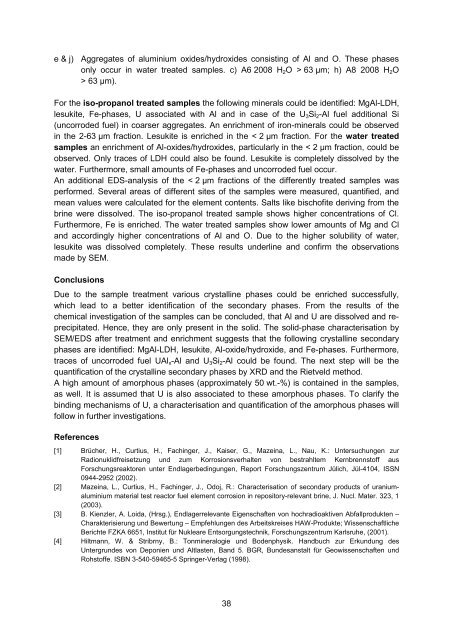Annual Report 2009/2010 - JUWEL - Forschungszentrum Jülich
Annual Report 2009/2010 - JUWEL - Forschungszentrum Jülich
Annual Report 2009/2010 - JUWEL - Forschungszentrum Jülich
Create successful ePaper yourself
Turn your PDF publications into a flip-book with our unique Google optimized e-Paper software.
e & j) Aggregates of aluminium oxides/hydroxides consisting of Al and O. These phases<br />
only occur in water treated samples. c) A6 2008 H 2 O > 63 μm; h) A8 2008 H 2 O<br />
> 63 μm).<br />
For the iso-propanol treated samples the following minerals could be identified: MgAl-LDH,<br />
lesukite, Fe-phases, U associated with Al and in case of the U 3 Si 2 -Al fuel additional Si<br />
(uncorroded fuel) in coarser aggregates. An enrichment of iron-minerals could be observed<br />
in the 2-63 μm fraction. Lesukite is enriched in the < 2 μm fraction. For the water treated<br />
samples an enrichment of Al-oxides/hydroxides, particularly in the < 2 μm fraction, could be<br />
observed. Only traces of LDH could also be found. Lesukite is completely dissolved by the<br />
water. Furthermore, small amounts of Fe-phases and uncorroded fuel occur.<br />
An additional EDS-analysis of the < 2 μm fractions of the differently treated samples was<br />
performed. Several areas of different sites of the samples were measured, quantified, and<br />
mean values were calculated for the element contents. Salts like bischofite deriving from the<br />
brine were dissolved. The iso-propanol treated sample shows higher concentrations of Cl.<br />
Furthermore, Fe is enriched. The water treated samples show lower amounts of Mg and Cl<br />
and accordingly higher concentrations of Al and O. Due to the higher solubility of water,<br />
lesukite was dissolved completely. These results underline and confirm the observations<br />
made by SEM.<br />
Conclusions<br />
Due to the sample treatment various crystalline phases could be enriched successfully,<br />
which lead to a better identification of the secondary phases. From the results of the<br />
chemical investigation of the samples can be concluded, that Al and U are dissolved and reprecipitated.<br />
Hence, they are only present in the solid. The solid-phase characterisation by<br />
SEM/EDS after treatment and enrichment suggests that the following crystalline secondary<br />
phases are identified: MgAl-LDH, lesukite, Al-oxide/hydroxide, and Fe-phases. Furthermore,<br />
traces of uncorroded fuel UAl x -Al and U 3 Si 2 -Al could be found. The next step will be the<br />
quantification of the crystalline secondary phases by XRD and the Rietveld method.<br />
A high amount of amorphous phases (approximately 50 wt.-%) is contained in the samples,<br />
as well. It is assumed that U is also associated to these amorphous phases. To clarify the<br />
binding mechanisms of U, a characterisation and quantification of the amorphous phases will<br />
follow in further investigations.<br />
References<br />
[1] Brücher, H., Curtius, H., Fachinger, J., Kaiser, G., Mazeina, L., Nau, K.: Untersuchungen zur<br />
Radionuklidfreisetzung und zum Korrosionsverhalten von bestrahltem Kernbrennstoff aus<br />
Forschungsreaktoren unter Endlagerbedingungen, <strong>Report</strong> <strong>Forschungszentrum</strong> <strong>Jülich</strong>, Jül-4104, ISSN<br />
0944-2952 (2002).<br />
[2] Mazeina, L., Curtius, H., Fachinger, J., Odoj, R.: Characterisation of secondary products of uraniumaluminium<br />
material test reactor fuel element corrosion in repository-relevant brine, J. Nucl. Mater. 323, 1<br />
(2003).<br />
[3] B. Kienzler, A. Loida, (Hrsg.), Endlagerrelevante Eigenschaften von hochradioaktiven Abfallprodukten –<br />
Charakterisierung und Bewertung – Empfehlungen des Arbeitskreises HAW-Produkte; Wissenschaftliche<br />
Berichte FZKA 6651, Institut für Nukleare Entsorgungstechnik, <strong>Forschungszentrum</strong> Karlsruhe, (2001).<br />
[4] Hiltmann, W. & Stribrny, B.: Tonmineralogie und Bodenphysik. Handbuch zur Erkundung des<br />
Untergrundes von Deponien und Altlasten, Band 5. BGR, Bundesanstalt für Geowissenschaften und<br />
Rohstoffe. ISBN 3-540-59465-5 Springer-Verlag (1998).<br />
38
















